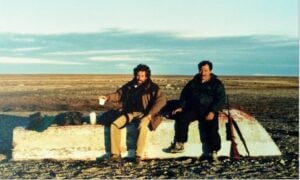7 June 1826, Pembroke, Wales: it’s the sixth year of the reign of George IV, eldest son of George III and Queen Charlotte. He is 63, with a quarrelsome marriage, a flauntingly extravagant lifestyle and an interest in architecture and the arts. Robert Jenkinson, 2nd Earl of Liverpool, a Tory, has been Prime Minister since 1812. The Zoological Society of London has just opened its doors. British explorers are out and about, and not just in the Arctic. Alexander Gordon Laing reaches Timbuktu in August, only to be murdered a month later by local tribesmen for refusing to relinquish his Christianity. In north Wales two great engineering achievements are being celebrated, as two of the world’s first suspension bridges, the Menai Bridge and the Conway Bridge, open within a few weeks of each other.
At the other end of Wales, in an estuary near the old fortified town of Pembroke, people are gathering on this early June morning for a somewhat smaller celebration. Cheered on by a crowd of engineers, carpenters, blacksmiths, clerks and their families, the stout, broad-hulled warship they have been building for the past two years slides, stern first, down the slipway at Pembroke Dockyard. The cheers rise to a roar as she strikes the waters of Milford Haven. She bounces, bobs and shakes herself like a newborn waterfowl. Her name is Erebus.
It wasn’t a cheerful name, but then she wasn’t built to cheer; she was built to intimidate, and her name had been chosen quite deliberately. In classical mythology Erebus, the son of Chaos, was generally taken to refer to the dark heart of the Underworld, a place associated with dislocation and destruction. To evoke Erebus was to warn your adversaries that here was a bringer of havoc, a fearsome conveyor of hell-fire. Commissioned in 1823, HMS Erebus was the last but one of a type of warship known as bomb vessels, or sometimes just “bombs.” They were developed, first by the French, and later the English, at the end of the 17th century, to carry mortars that could fling shells high over coastal defences, doing maximum damage without an armed landing having to be risked. Of the other ships in her class, two were named after volcanoes — Hecla and Aetna — and the others after various permutations of wrath and devastation: Infernal, Fury, Meteor, Sulphur and Thunder. Though they never achieved the heroic status of the fighting warships, their last action, the siege of Fort McHenry in Baltimore Harbour in the War of 1812, came to be immortalized in the American national anthem, The Star Spangled Banner: “the rockets red glare, the bombs bursting in air” refers to the fire from British bomb ships.
It was a proud day for the shipbuilders of Pembroke when Erebus went down the slipway, but as she was steadied and warped up on the banks of the Haven, her destiny was unclear.
***
She was not to be a big ship. At 104 feet, she was less than half the length of a standard man-o’-war, and at 372 tons she was a minnow compared to Nelson’s 2,141-ton Victory. But she was to be tough. And more like a tugboat than a sleek and fancy ketch. Her decks and hull had to be strong enough to withstand the recoil from two big onboard mortars, one 13-inch, the other 10-inch. She therefore had to be reinforced with diagonal iron bracing bolted to the planking in the hold, strengthening the hull whilst reducing her weight. She also had to have a hull capacity wide and deep enough to store heavy mortar shells. In addition, she was to be armed with ten small cannons, in case she should need to engage the enemy on the water.
Erebus was built almost entirely by hand. First the keel, most likely made of sections of elm scarfed together, was secured on blocks. To this was attached the stem, the upright timber in the bow, and at the other end of the ship the sternpost, which supported the rudder. The frame, made of oak from the Forest of Dean in Gloucestershire and shipped on barges down the River Severn, was then fitted around these heavy timbers. This task demanded a high level of skill, as the shipwrights had to find exactly the best part of the tree to match the curvature of the boat, whilst taking into account how the wood might expand or contract in the future.
Once the frame was in place, it was allowed time to season. Then three-inch planking was fitted from the keel upwards, and the deck beams and decking boards were added.
Erebus was not built in a hurry. Unlike her future partner, HMS Terror, built at Topsham in Devon in less than a year, it was 20 months before she was ready to go down the slipway. When the work was completed, the Master of the Cheque sent a bill to the Navy Board for £14,603 — around £1.25 million in today’s currency.
***
After her launch at Pembroke, Erebus was taken, as was common practice, to a different Admiralty yard to be fitted out. Not yet equipped with a full rig of masts and sails, she would likely have been towed south-west, around Land’s End and up the English Channel to Plymouth. There, at the busy new dockyard that would eventually become the Royal Navy’s Devonport headquarters, she would have been transformed into a warship, complete with ordnance: two mortars, eight 24-pound and two 6-pound cannons, and all the machinery for storing and delivering the ammunition. Her three masts would have been hoisted, the mainmast towering 140 feet above the deck.
But after this flurry of activity came a prolonged lull. Though armed and prepared, Erebus was stood down In Ordinary (the term used to describe a ship that had no work). For 18 months she rode at anchor at Devonport, waiting for someone to find a use for her.
I wonder if there were such things as ship-spotters then: school boys with notebooks and pencils recording the comings and goings around the big yards, as I used to do with trains, in and out of Sheffield. I imagine they could have become attached to the brand-new, chunky-hulled, sturdy three-master that seemed to be going nowhere. She had a touch of style: her bow ornately carved, her topside strung with gun-ports, and at her stern more decoration around the range of windows on the transom, and the distinctive projecting quarter-galleries housing water-closets.
If, however, they’d been about early in the dark winter mornings at the end of 1827, they would have been rewarded with the sight of something stirring aboard HMS Erebus: covers being pulled back, lamps lit, barges pulling alongside, masts being rigged, yards hoisted, sails furled. In February 1828, Erebus made an appearance in the Progress Book, which kept a record of all Royal Navy ship movements. She was, it noted, “hove onto Slip, and took off Protectors, coppered to Load draught.” These were all preparations for service. Hauled out of the water onto a slipway, she would have had the protective timber planking on her hull removed and replaced with a copper covering, up to the level at which it was safe to load her (what was soon to be called the Plimsoll line). Since the 1760s the Royal Navy had been experimenting with copper sheathing to try and prevent the depredations of the Teredo worm — “the termites of the sea” — which burrowed into timbers, eating them from the inside out. Coppering meant that a voyage was imminent.
On 11 December 1827 Commander George Haye, RN stepped aboard to become the first captain of HMS Erebus.
Excerpted from Erebus by Michael Palin. Copyright © 2018 Michael Palin. Published by Random House Canada, a division of Penguin Random House Canada Limited. Reproduced by arrangement with the Publisher. All rights reserved.




